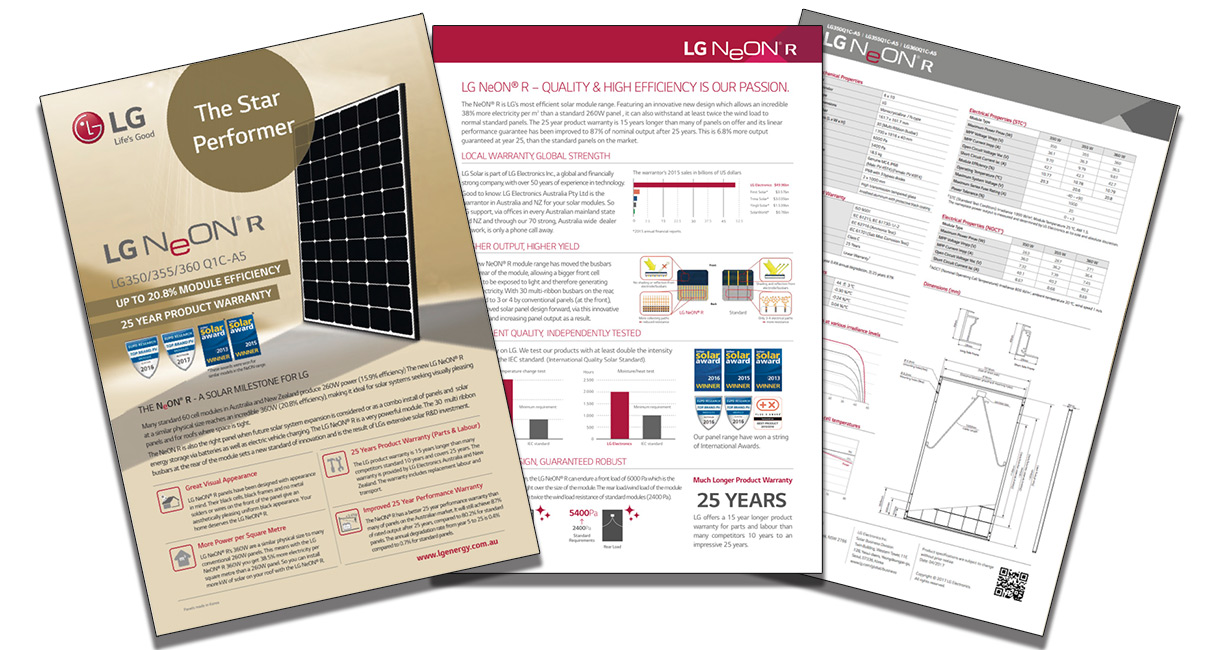
LG’s NEoN-R panel is very good, very well warranted and very expensive.
LG Solar has introduced a new high efficiency solar panel they call the LG NeON R.
While the name makes it look like LG’s company laptop has a defective Caps Lock key, as far as I’m aware there is nothing wrong with the panel itself. It has 60 cells, which is standard for rooftop solar, and ranges from 350 to 365 watts, which makes it one of the most powerful panels available.
It’s an impressive piece of technology with an efficiency of up to 21.1%, which is well above average. But what really makes it stand out from LG’s other panels and almost everything else on the Australian market, is its 25 year replacement product warranty. Currently only SunPower offers the same level of warranty protection.
At time of writing they have just landed in Australia, ready to be dispatched to LG distributors around the country. But they are not cheap, but that’s to be expected for what is clearly a premium product. While it is unfortunately not always true that you get what you pay for, it is true that you never get what you don’t pay for.
LG Is Not A Small Company
LG is a huge South Korean company with over 200,000 employees that produces solar panels and many other things. The odds look good they’ll exist long enough to honor their 25 year replacement warranty.
LG Panels Are Tier One And High Quality1
My advice when it comes to buying solar panels is to get ones that are tier one or are known to be reliable.
LG panels are tier one at time of writing and they are reliable.
Interestingly, LG were not classed as tier one for the first quarter of 2017. How could this be?
The title tier one merely means a panel is considered dependable enough by large financial organizations to be a low risk when to comes to lending money to large-scale solar projects that use them. But the drawback is if a company’s panels aren’t used in enough large solar projects they won’t be considered tier one no matter how good they are. As LG has concentrated on the premium end of the rooftop solar market, they had a quarter without enough large-scale projects and were temporarily no longer considered tier one.
In my opinion, LG panels are a cut above many that are classified as tier one and the fact they were not classified that way for 3 months is no reason not to use them.
LG Provides A Full Replacement Warranty
Unlike the majority of solar panel manufacturers LG offers a full replacement warranty, provided you live in or near a metropolitan area. This means if your panel has a fault LG will not only give you a new panel, they will also send someone out to replace it free of charge.
LG offers this service for their standard panels for 15 years, but for the NeON R it is for the full 25 years of its product warranty. This is great for peace of mind, although it does add to the cost. LG told me it costs around 10 cents per watt to give the extra warranty, so you will pay for it.
You Are Extremely Unlikely To Need To Use The Warranty
While the 25 year replacement warranty is excellent you are very unlikely to ever need to use it. Markus Lambert, LG’s National Sale’s Manager, told me that out of 400,000 LG panels installed so far in this country, they have only had to replace eight. And he strongly implied some of those were a pity replacement to mollify a grumpy customer and not LG’s fault.
While this doesn’t mean there is only a one in 62,5000 chance of the panels failing over the next 25 years, as they haven’t been around long enough for us to know that, it is a very good indicator they are reliable.
They Are The “Ferrari” Of Solar Panels
Markus told me the LG NeON R was the Ferrari of solar panels. Clearly, these are the words of a man who has never owned a Ferrari. My friend Pigdog has one and he spends more time with his mechanic than his wife2. If he wanted to impress me, he should have told me it was the Toyota Corolla of solar panels.
Big
The LG NeON R is from 350 to 365 watts, which makes it one of the highest wattage 60 cell panels around. Its high efficiency isn’t enough by itself to get its watts up to 350 or more, so it is also about 5% larger than the average 60 cell panel. This isn’t a lot, but it is something to keep in mind when determining how many can fit on a roof. Despite their slightly larger size, they manage to only weigh 18.5 kilograms.
But for some reason their brochure says,
“LG NeON® R’s 360W are a similar physical size to many conventional 260W panels.”
It is true that only 5% larger is of “similar size”. But if they had written, “These are probably the biggest 60 cell panels you can find,” it would also have been true.
Hot
When panels get hot their efficiency goes down. It’s common for panels in full sunshine to be 20 degrees hotter than air temperature when there’s not much wind.
The number that shows how well panels handle heat is called the temperature coefficient of the maximum output power or just Pmax for short. The average is about -0.4%, but the LG NeON R does considerably better with -0.3%. This means a panel that operates at 20.8% efficiency when it is 25 degrees will only fall to 19.6% efficiency when its temperature rises to 45 degrees.
Topless
The panel’s cells have no busbar wires on top of them. This helps efficiency because there is nothing shading the cell. SunPower Maxeon cells manage to appear topless by having a conductive transparent layer over their surface, but I don’t know if LG uses the same method.
And if aesthetics is more important to you than efficiency, there is an all black version of the LG NeON R that is 350 watts.
They Are Not Cheap
Since SolarWorld went broke last week, there are only 2 ultra-premium solar panel players left selling in to Australia: LG and Sunpower. Sunpower provide a 25 year replacement warranty on all their panels sold in Australia. LG’s default is 15 years – with the 25 year NeON Rs being the exception.
I have been told the NeON R panels will cost from $1.10 to $1.13 a watt. This means they are a similar price to SunPower’s most expensive panels, but more expensive than Sunpower’s cheaper models.
If you want to buy top of the range panels, for top dollar, with a proper 25 year replacement warranty then you now have a choice: Sunpower or LG NeON R.
This post was updated in March 2018 to reflect the new efficiencies, size and pricing of NeonR panels


 RSS - Posts
RSS - Posts



It would be interesting to see how they compare with other LG panels considering price and efficiency. Two years ago I installed LG 300 W panels. This year I added LG 320 W panels. It seems every year they bring new panels. is the difference in efficiency justify the extra costs?
I’ve just started reading Ronalds posts, he is my new hero 😛
I hope the new AC Modules that LG and Enphase are coming out with eventually integrate the IQ7 with the NeON-R panels; that would be a seriously powerful decentralized power solution with 100% fault-tolerance and true reliability.
G’day Ronald, thanks again for another great article mate. Upon reading your article, on question comes to mind, and if you know off the top of your head, can you advise what the competing model and price per watt of Sunpower would be by comparison please mate. Cheers Peter
Hello Peter, all SunPower panels differ in some ways from the LG NeON R, so they’re not quite directly comparable, but looking at SunPower’s Australian site I see they sell the X21 which is 21% to 21.5% efficient and then there’s their E20 which is 19.9% to 20.4% efficient. The X series costs more than the E series, but I’m afraid I know the current prices for either off hand. Last I heard, SunPower panels were less than three quarters the $1.35 to $1.40 price I was given for LG NeON R panels, but that may have changed by now.
“While the name makes it look like LG’s company laptop has a defective Caps Lock key, as far as I’m aware there is nothing wrong with the panel itself.”
Best way to start an article ever. Haha
But overall really great review. I’m learning heaps from your site.
Sadly deluded. Doing so many things right… but…
http://www.news.com.au/finance/economy/a-64-energy-bill-how-kim-saved-power-at-her-baulkham-hills-home/news-story/0ebfb4a9df2ac5619a42e511f4e56d4c
“Despite their slightly larger size, they manage to only weigh 18.5 kilograms.”
This is because LG panels have thinner 2.8mm glass. Most other solar panels have 3.2mm glass
As a rule of thumb, you can calculate glass weight by Glass Width (m) x Glass Length (m) x Glass Thickness (mm) x 2.5
By using thinner glass, LG reduced the panel weight by approx 1.5 – 2 kg.
No doubt this reduced costs too.
Are the LG NeON R available in California homes now?
No idea, but they’d have an extra 30% tariff on them now.